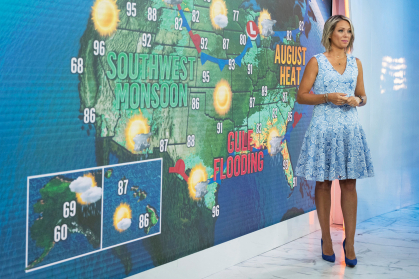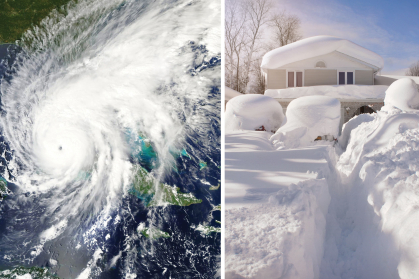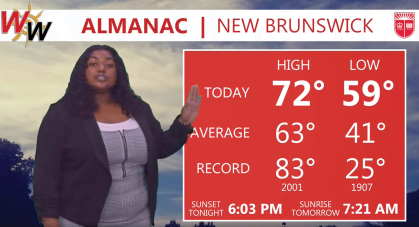Preparing Tomorrow's Meteorologists

As a little boy growing up in Bayonne, New Jersey, Jeremy Lewan was fascinated by rainstorms. Wearing his miniature galoshes and gripping his pint-sized umbrella, he would persuade his parents to take him outside while the wind whipped around them and the rain came down in sheets. Jeremy intently watched leaves float down the streams of runoff until they reached the storm grate and disappeared. His wonder deepened as he became enamored with extreme weather such as hurricanes, tornadoes, and blizzards. For his 6th birthday, his mother gave him a children’s weather station, and his kindergarten teacher gave him the OK to give a daily weather report to the class.

In November 2022, Lewan SEBS’22 began his first job as a broadcast meteorologist, working weekends at WNEP-16, the ABC-TV affiliate in Scranton, Pennsylvania, which represents the 58th largest television weather market in the nation. As he was completing his education at Rutgers, Lewan interned for three semesters at NBC, contributing in myriad ways to the Today show, NBC Nightly News With Lester Holt, MSNBC, and NBC News and working closely with the most famous weather anchor of all, Al Roker. According to NBC, Lewan may have been the best intern the network has had, earning high marks for his work ethic and impressive academic preparation to handle any task thrown his way.
How did Lewan go from kindergarten weatherman to professional weatherman with such apparent ease? He is among the alumni who have graduated from, as Lewan puts it, the “small but mighty” meteorology undergraduate program at the School of Environmental and Biological Sciences at Rutgers University–New Brunswick, the only such program offered in New Jersey. (There is also a graduate program in atmospheric science.) Like Lewan, most current students and alumni working in a variety of meteorological careers today were drawn to the field as young children after witnessing a dramatic storm or developing an early fascination with the weather.

“Coming into the meteorology program, just about every student is aware of broadcast meteorology and weather forecasting,” says Steven Decker, director of the undergraduate program since 2015 and an associate teaching professor in the Department of Environmental Sciences (the oldest academic environmental sciences department in the nation). “They know about the Weather Channel, the National Weather Service, AccuWeather. But what they don’t know are all the things that you can do with a meteorology degree. During their time at Rutgers, they learn all about these other career paths.”
Some students become research scientists, serving in either academic or government laboratories where they conduct weather and climate research. One laboratory, in Princeton, New Jersey, is the Geophysical Fluid Dynamics Laboratory, which is affiliated with the National Oceanic and Atmospheric Administration (NOAA) and conducts climate and ocean research studies and modeling. Other graduates become scientific programmers, working for companies like Raytheon Technologies and other government contractors, which, among other things, manufacture both military and weather satellites, products that require programmers to operate them to function in real weather conditions.
Some alumni work for private weather- consulting companies like AccuWeather. Several are employed at WeatherWorks, in Hackettstown, New Jersey, which provides organizations in the public and private sectors with meteorological services. Agribusiness is one sector of the economy where companies rely on accurate, tailored weather forecasts. Mars, the maker of M&Ms, for instance, needs to know if a sugarcane yield in Brazil will be affected by inclement weather, prompting the company to hedge against a poor yield in commodities markets. To that end, financial trading firms might well have a meteorologist on staff, advising traders on how pending weather will influence the cost of, say, natural gas, providing an opportunity to profit from, or limit losses in, changing prices affected by the weather.
Companies like Amazon and FedEx, whose lifeblood is the prompt delivery of goods, employ meteorologists to provide forecasts for specific locations throughout the nation to determine whether deliveries can be made on time. Alumnus Adam Rusak SEBS’20 works for Weather Routing Inc., directing ships crossing the world’s oceans on courses to maximize fuel economy and avoid storms. Likewise, alumna Jennifer Kafka, who has undergraduate and graduate degrees in meteorology from Rutgers, has advised large shipping companies when to transport temperature- sensitive goods across the country in 18-wheelers so that they can avoid using costly refrigerated trucks. “Our internal tool would use weather models and forecasts that help companies plan a better route,” says Kafka SEBS’12, GSNB’20. Today, she uses large-scale weather data to assess the cost of changing climate on a company’s bottom line. There are even career opportunities as forensic meteorologists, who are retained in personal injury lawsuits to ascertain and testify what the weather conditions were when a plaintiff was injured.
Guaranteed Employment
The range of career opportunities that a meteorology degree bestows translates into a very high employment rate among graduates, according to a 2019 survey by the U.S. Census Bureau. In working toward an undergraduate degree at Rutgers, students choose one of three concentrations. “Operational meteorology” involves weather forecasting. “Environmental meteorology” addresses air pollution and air-quality monitoring and modeling. The “climate” concentration focuses on the changing climate. All told, roughly half of the graduates pursue jobs in the private sector; one-third of the students go on to graduate school to pursue a research path; and others find careers as broadcast meteorologists—literally the most visible application of a meteorology degree.

Graduates work for local television affiliates and national broadcasters, some in front of the camera and others behind it as producers. Alumna Dylan Dreyer, one of the most well-known on-camera graduates, works with Al Roker as a meteorologist on the Today show, where she is also a host of the 3rd Hour. At Rutgers, she passed on her initial interest—engineering—and opted for meteorology after taking the introductory course “Meteorology 101,” the catalyst for her dream to become a broadcaster. “I had always had a fascination with weather, and taking that class really helped me decide to major in it,” Dreyer SEBS’03 said in a video produced by NBC News in which she explains why she attended Rutgers. “So, I ended up switching over to meteorology, which made use of all my physics and science and math classes. A lot of the skills that I picked up at college were mostly through academics. I had to put aside any social life and really study and work hard. I notice in this business, when the alarm goes off at four o’clock in the morning, you know there’s not a lot of partying the night before.”

Alumnus Joe Martucci, who also knew he wanted to be a broadcaster as a little boy, recalls the rigors of the program. “It was tough, and it was challenging. But the program taught you to break out of your shell and reach out for help when you needed it—which is a great life lesson,” says Martucci SEBS’13, today the meteorologist for The Press of Atlantic City. “Although I like being with people, I was pretty shy when I came to Rutgers. The program challenged me to be more comfortable talking in front of others.”
How's the Weather?
The undergraduate program provides a comprehensive mastery of the principles of meteorology, which, according to the program’s website, is “the study of weather, climate, and the characteristics, structure, and processes of the atmosphere. Students learn how to forecast the weather and how to understand climate change. The emphasis of the bachelor of science degree in meteorology is on developing a broad understanding of the fundamental physical and dynamic processes governing the motions and behavior of the atmosphere and its interactions with the underlying land and ocean surfaces.”
The instruction has several complementary components. The classroom curriculum is freighted with a demanding concentration of physics, chemistry, and, most daunting of all, calculus, the branch of mathematics that describes change—and weather, of course, is always changing. The calculus demands can be a deal-breaker for many students, and it accounts for why graduating classes range from only 10 to 20 students. “It was not easy; that’s for sure,” says Lewan. “The program requires an enormous amount of determination, persistence, and grit to complete not only the foundational courses, but also the higher-level meteorology classes that incorporate all of the difficult concepts learned in those foundational courses.” Nonetheless, Lewan managed to impressively maintain a perfect 4.0 GPA at Rutgers while being involved in a host of extracurricular activities, from modeling to promoting diversity. He won the 2022 Meteorology Student of the Year award his senior year.
“The calculus requirements can be a stumbling block for some students,” Decker says. “They are really enthusiastic about the weather, but they just can’t get over the hump of calculus and end up pursuing another major. In my pitch to prospective students, I make it clear that the meteorology program is a math-heavy major. So, I tell them to be ready for that.”

Outside the classroom, first-year and transfer students are invited to participate in the WeatherWatcher thematic community, a living-learning environment in Perry Hall on the George H. Cook campus where idle conversation is invariably about the weather. Meteorology students, even those who are not part of the living-learning community, take turns practicing their broadcasting presentations in a television studio within the residence hall that is equipped with the same professional equipment, graphics systems, and software used in most news stations nationwide. Student broadcasts, published three times a day, are available on the WeatherWatcher’s Facebook page, based on weather data available at the Rutgers Weather Center website.
“When it comes to broadcasting,” Decker says, “it is very much practice makes perfect. Once a student has been doing it for a year or so, their delivery is no longer stiff as they feel more comfortable, and you get a sense that you are glimpsing the student’s true personality.”

The opportunity to practice broadcasts helped sophomore Andrea John, who is double majoring in meteorology and communication, decide to concentrate on broadcast meteorology. But other facets of meteorology attract her, too. “I would also love to do research and become a forensic meteorologist. And I have hopes to obtain my master’s in meteorology as well as a Ph.D.”

First-year student Derek Diehl is intrigued with the prospects of a broadcasting career. “I’m undecided what I plan to do with my meteorology major,” says Diehl, who intends to minor in geography. “I hope to land internships with the National Weather Service or a TV station that will help me decide if I want to be on screen or work behind the scenes.”
The WeatherWatcher Club and Meteorology Club foster friendships and camaraderie as students share the challenges of the curriculum and complete coursework. Given the small class sizes, students are bound to form close ties to one another—and to dedicated faculty members. “We had an extremely strong support system in the professors, who helped us succeed in attaining our degrees,” Lewan says. “They were always there for us after class to answer questions and give us guidance, especially during the pandemic when we really needed it.”
Students also gain additional experience outside the classroom by taking the summer elective “Severe Weather Forecasting,” a two-week course introduced in 2012 and available every other year. It’s a rare opportunity to see theory meet reality under the big skies of the Great Plains as Decker and students drive thousands of miles in a flotilla of vans monitoring and then chasing the tornadoes that are frequent occurrences during the summer months. In class, students have learned about the atmospheric “ingredients” necessary to create favorable conditions for severe storm development. And they have learned to distinguish ordinary thunderstorms and supercell thunderstorms, which are capable of producing tornadoes. Out on the road, the group starts each morning by assessing the atmospheric conditions. They apply their knowledge to predict the conditions most favorable for severe storm formation in the afternoon and drive to the location. If they have hedged their bets right, they watch storms develop in front of them, noting whether the storm has tornadic qualities. “The best part of this course was observing how the theoretical equations that define severe weather development translated into actual storm development (and even a tornado) in real life,” Kafka says.
During last year’s trip, which covered 7,800 miles ranging from New Mexico to South Dakota, Decker and his students were chasing developing tornadoes in eastern Colorado and southern Nebraska. As they spotted one forming and heading south out of Nebraska, a rare tornado condition was occurring. In 99 percent of tornadoes, known as cyclonic tornadoes, the air rotates counterclockwise. But as the skies grew dark and brooding, the team came across a tornado twisting clockwise, or in an anticyclonic rotation. “This was a remarkable sight for me and the students,” Decker says. “Seeing the smiles and excitement, but also their understanding of why things were happening, was the highlight of the trip.”

Founding Fathers as Meteorologists
These budding meteorologists are upholding an age-old tradition of tracking the weather. When Thomas Jefferson came to Philadelphia to participate in the adoption of the Declaration of Independence, he recorded the temperature on July 4, 1776 (76 degrees, naturally), using a thermometer purchased from a Philadelphia merchant. He took daily readings for years at his Monticello estate in Virginia as well. George Washington also made regular weather observations; his last entry was recorded in his diary the day before his death in December 1799. Over the better part of the next century, observation posts for recording the weather—essentially mom-and-pop operations—sprung up around the nation, with data sent to a central location via telegram. The next step—forecasting the weather—required the kind of organization that only a government agency could provide.
In 1870, U.S. President Ulysses S. Grant created a national weather bureau, following the passage of a congressional resolution stipulating that the Secretary of War should “provide for taking meteorological observations at the military stations in the interior of the continent, and at other points in the States and Territories ... and for giving notice on the northern lakes and on the seacoast, by magnetic telegraph and marine signals, of the approach and force of storms.” The new national weather bureau was part of the U.S. Army Signal Service’s Division of Telegrams and Reports for the Benefit of Commerce.
As New Jersey’s land-grant university, Rutgers became part of that recording and reporting network in 1893 when it established, largely for the sake of the state’s farmers, the first Rutgers weather station. The current incarnation, located in Rutgers Gardens for more than 50 years, has been reporting daily maximum and minimum temperatures, rainfall, snowfall, snow depth, air quality levels, soil temperatures, and historic weather events. NOAA’s National Weather Service gave Rutgers its 2021 Honored Institution Award for “125 years of distinguished service to the nation through the Cooperative Observer Program.”
“Our station is somewhat different because it is institutional,” Decker says. “We have had students take official observations every day for more than 50 years, taking measurements and contributing to this long, long time series. And this is important because this is how you can quantify things like climate change—through observation.”
Much of what Martucci had observed and learned during his four years in the program was turned on its head when Superstorm Sandy bore down on Atlantic City, New Jersey, in October 2012. The hurricane, he could see, was defying the typical behavior of such storms. “The most impressive part of Sandy was the unusual track it took,” says Martucci, who was a senior at the time. “At this latitude, hurricanes and systems like this typically move to the north or east. But this storm went due west into Atlantic County. A high-pressure system over Newfoundland blocked it from going out to sea. And the jet stream—the river of air about 30,000 feet high that separates two air masses—was to the west. So, that jet stream pulled it toward the Jersey Shore.”
Today, Martucci works in Atlantic City as the meteorologist for The Press of Atlantic City, the only newspaper in New Jersey that employs a full-time meteorologist. He presents the weather through the publisher’s social media and digital outlets, which have the advantage of allowing the public to take in his forecasts when they want to. “My presentations require a different mindset,” he says. “Because most of what I do is recorded, I’m not showing the current radar, temperatures, and winds that often. Rather, I’m more focused on the future, using the present to build that story.”
On a Mission for Meteorology
Lewan has a story he wants to tell. As he embarks on what promises to be a long, successful career as a broadcast meteorologist, Lewan is fulfilling the lifelong dream that began when he was a child. But the dream, he believes, will be fully realized only if more people who look like him and have a similar background can participate in meteorology. As of 2020, nearly 90 percent of meteorologists were white; in broadcast meteorology alone, 92 percent of chief broadcast meteorologists—normally the face of the entire weather department—were white as well. Similar statistics mirror the lack of diversity in all the geosciences. Lewan is fully aware of these facts, and he intends to serve as an example. “My very presence in broadcast meteorology—as a confident, multiracial minority individual—will distinguish me from the vast majority in this field,” he says. “I aim to champion diversity, equity, and inclusion in meteorology by proudly representing my different ethnicities on screen and, in the process, actively dismantling stereotypes and serving as a role model for minorities who look like me.”